In the high-stakes environment of a cardiac cath lab, standard monitors can obscure fine details. This leads to procedural uncertainty and potential risks during delicate interventions.
This article explores the clinical advantages and technical requirements of medical-grade monitors in cardiac interventions. I will cover key specifications, compliance standards, low-latency performance, and multi-modality visualization to guide effective procurement.
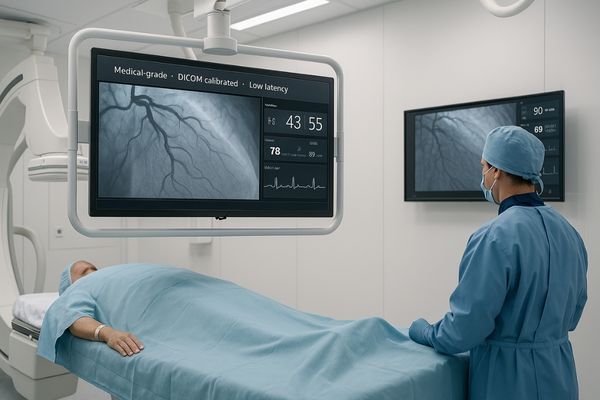
The cardiac catheterization lab is an environment where millimeters matter. Navigating complex coronary arteries or precisely deploying a stent requires exceptional visual clarity and confidence. Using a standard, non-medical display in this setting introduces an unacceptable level of risk. Consumer-grade monitors lack the brightness, contrast, and crucially, the regulatory certifications required for patient-critical applications. Their image processing can introduce delays, creating a disconnect between the operator’s hand movements and the live fluoroscopic image. This discrepancy can lead to vessel injury or inaccurate stent placement. A medical-grade monitor1, by contrast, is engineered specifically for this purpose. It provides the high fidelity, real-time performance, and safety assurances necessary for modern interventional cardiology. A purpose-built display like the MS551 is designed to provide this level of confidence, ensuring that what the clinician sees is an accurate, immediate representation of the patient’s anatomy, free from distortion or delay.
Clinical Advantages of Medical-Grade Monitors in Cardiac Interventions
Relying on consumer displays in cath labs can mask subtle vascular details, risking misplacement of devices. This ambiguity compromises both diagnostic accuracy and patient safety during procedures.
Medical-grade displays provide superior resolution, brightness, and contrast, revealing fine details of catheters and vessels. This enhances diagnostic accuracy, ensures real-time sync, and reduces procedural errors in complex cardiac interventions.
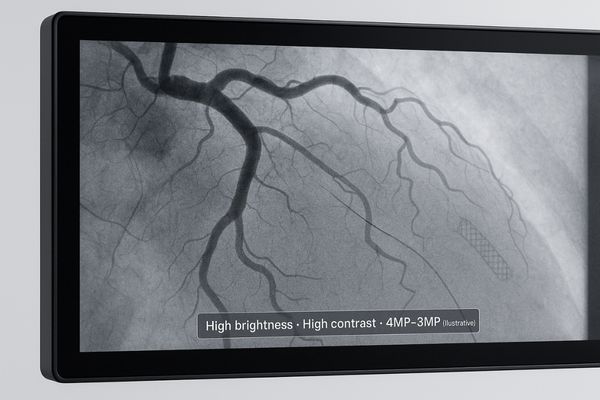
The clinical benefits of using a certified medical-grade monitor in cardiac interventions are direct and measurable. These displays are engineered to a higher standard of performance, with resolutions often in the 4MP to 8MP range and brightness levels between 500 and 1000 cd/m². This is significantly higher than consumer displays and allows for the clear visualization of the tiniest guide wires, catheter tips, and faint vessel borders, even in the bright ambient light of a cath lab. The high contrast ratio, typically exceeding 1000:1, ensures that these instruments stand out against the surrounding anatomy. Academic studies have consistently shown that radiologists and cardiologists achieve higher diagnostic accuracy, as measured by Receiver Operating Characteristic (ROC) curve analysis2, when using medical-grade displays3 versus consumer monitors. This translates to fewer missed lesions and a reduction in false positives. These combined strengths provide the visual clarity needed for complex procedures like chronic total occlusions (CTOs), where every anatomical detail is critical for success.
| Feature | Medical-Grade Monitor | Consumer-Grade Monitor | Clinical Impact of Medical-Grade |
|---|---|---|---|
| Resolution | 4MP–8MP+ | Typically FHD–4K (often with image scaling) | Clearer visualization of fine vascular structures and devices. |
| Brightness | 500–1000 cd/m² | 250–400 cd/m² | Overcomes ambient light, prevents image washout. |
| Latency | <10 ms | 20–50+ ms | Ensures real-time hand-eye coordination for procedural safety. |
| Compliance | DICOM Part 14, IEC 60601-1 | None | Guarantees perceptual uniformity and electrical safety. |
Key Technical Specifications for Cath Lab Imaging
Selecting a monitor without understanding cath lab-specific needs leads to poor image quality. This can obscure critical anatomical landmarks, directly impacting the precision of the intervention.
Essential cath lab display specifications include 4K resolution for multi-modality viewing, brightness above 500 cd/m², and 10-bit grayscale. DICOM Part 14 compliance is crucial for accurate perception of subtle vessel details.
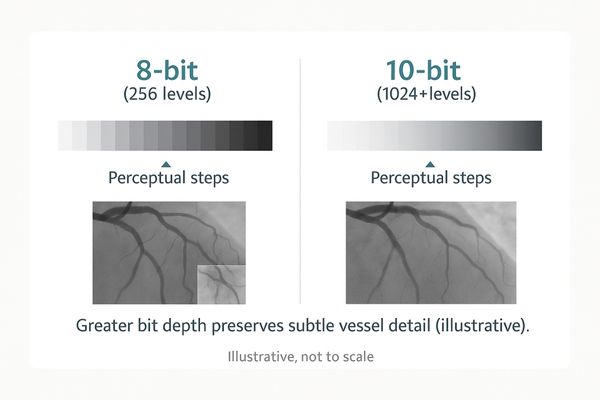
In the context of a cardiac cath lab, a monitor’s technical specifications are not just numbers on a data sheet; they are determinants of clinical efficacy. Resolution is paramount. A 4K (8MP) display4 has the pixel density to show four separate full HD video sources simultaneously without downscaling or loss of detail. This is perfect for displaying live fluoroscopy, intravascular ultrasound (IVUS), hemodynamic data, and an EKG trace on a single screen. Brightness must be sufficient to cut through the high ambient light of the lab; a minimum of 500 cd/m² is recommended for interventional use, compared to the 350 cd/m² baseline for diagnostic radiology. Furthermore, 10-bit grayscale capability is essential. It provides over 1024 distinct shades of gray, compared to the 256 shades of an 8-bit panel. This vast range allows for the visualization of very subtle differences in tissue density or the flow of contrast media. Tying this all together is DICOM Part 14 calibration5, which ensures these grayscale steps are perceptually linear, making faint vessel borders consistently visible.
Regulatory Compliance and Safety Standards
Using uncertified monitors in a patient environment is a significant liability. These devices can cause electromagnetic interference with critical life-support equipment or pose electrical safety hazards.
Certified medical monitors meet strict safety and performance standards like IEC 60601-1 and hold FDA or CE MDR clearance. This ensures they are safe for patient-vicinity use and will not disrupt other medical devices.
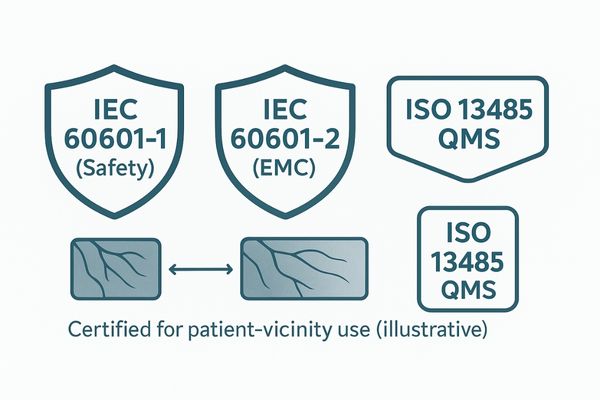
Regulatory compliance is a non-negotiable requirement for any equipment used in a cath lab. Medical-grade monitors are legally classified as medical devices and must adhere to a stringent set of international standards. In the United States, this typically means securing FDA 510(k) clearance6, while in Europe, CE marking under the Medical Device Regulation (MDR) is required. Central to these certifications is compliance with the IEC 60601 family of standards7. Specifically, IEC 60601-1 governs basic safety and essential performance, ensuring the device is protected against electrical shocks. IEC 60601-1-2 addresses electromagnetic compatibility (EMC), guaranteeing that the monitor does not emit disruptive interference that could affect pacemakers or other sensitive equipment, nor is it susceptible to interference from devices like electrosurgical units. Manufacturers of reputable medical displays operate under a certified ISO 13485 quality management system. This demonstrates that their design, production, and testing processes are rigorously controlled to build safe, reliable, and effective medical devices. Choosing a certified monitor is a fundamental step in mitigating risk for both the patient and the institution.
Real-Time Performance and Low Latency
A millisecond delay between catheter movement and the on-screen image can be disorienting. This latency compromises the precise hand-eye coordination needed for navigating delicate cardiac vessels.
Medical-grade monitors feature near-zero latency, typically under 10 ms, ensuring perfect sync between instrument movement and the live image. This real-time feedback is essential for procedural accuracy and safety.
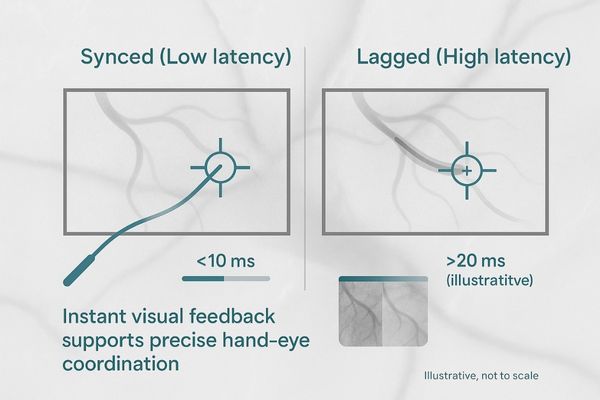
In cardiac interventions, the link between the operator’s hands and the visual feedback on the screen must be instantaneous. Any perceptible delay, or latency, can have serious consequences. A cardiologist relies on immediate visual confirmation when advancing a guide wire or deploying a stent. If the monitor introduces processing delays, the image on the screen will lag behind the physical movement of the device. This forces the operator to slow down or make predictive movements, increasing the risk of vessel perforation or inaccurate device placement. Medical-grade monitors are engineered to minimize this video processing pipeline8. They can achieve latencies of less than 10 milliseconds while maintaining a high refresh rate of 60Hz or more, even at 4K resolution. This ensures a fluid, real-time connection between the imaging system, the display, and the clinician. Consumer displays, in contrast, often have image enhancement features that can add tens of milliseconds of delay, making them entirely unsuitable for any interventional procedure where hand-eye coordination is critical.
Multi-Modality Visualization for Procedural Efficiency
Toggling between multiple screens for different imaging modalities is inefficient. Constantly turning your head distracts from the procedure, slows down decision-making, and increases the risk of error.
Large-format 8MP displays enable simultaneous, full-resolution viewing of fluoroscopy, echo, 3D maps, and vitals on one screen. This enhances situational awareness, streamlines workflow, and reduces procedural delays.
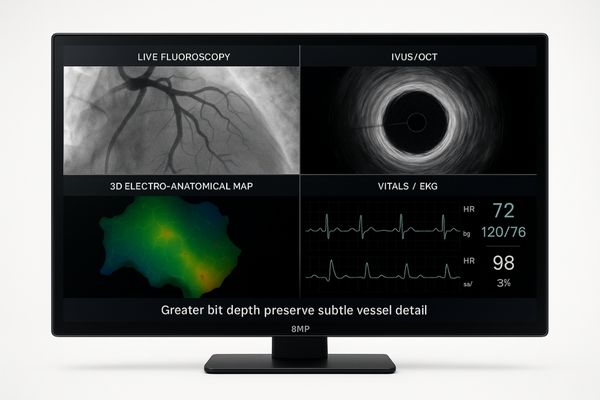
Modern cardiac interventions are data-rich procedures that rely on multiple imaging and information sources. A single large-format 8MP or 12MP medical display is a powerful tool for improving procedural efficiency. By consolidating live fluoroscopy, intracardiac echo (ICE), 3D electro-anatomical maps, and hemodynamic waveforms onto a single screen, the entire clinical team gains a unified view of the patient’s status. This concept, known as image fusion9, eliminates the need for clinicians to turn their heads between different monitors, which can be a significant source of distraction and delay. Case studies have shown that replacing a setup of multiple 2MP monitors with a single large display, such as the MS431P, can tangibly improve workflow. It allows for faster interpretation of data, better team communication, and enhanced situational awareness. For the operator, having all critical information within a single field of view shortens the time between observation and action, which can be crucial during complex stages of a procedure. This streamlined approach not only improves efficiency but also contributes to a more ergonomic and less fatiguing work environment for the entire cath lab team.
Procurement Criteria and Common Pitfalls
Choosing a monitor based on price alone is a common but costly mistake. An under-specified display can compromise clinical work, leading to diagnostic errors and premature replacement.
Focus on resolution, brightness, DICOM calibration, and certified compliance. Avoid consumer-grade displays, and ensure the monitor’s specifications match the imaging system’s output and the lab’s ambient lighting conditions.
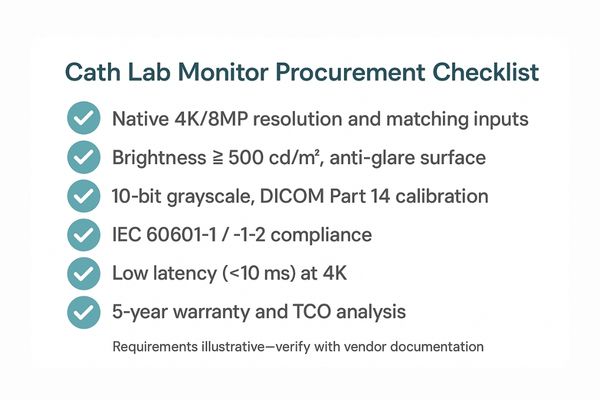
A structured procurement process is essential to avoid common pitfalls when selecting monitors for a cardiac cath lab. The primary criteria should always be driven by clinical need, not just the capital budget. It starts with matching the monitor’s resolution and input capabilities to the imaging chain. A 4K imaging system10 requires a native 4K display to realize its full potential. The single most common pitfall is the use of consumer-grade displays. These devices lack the stable DICOM calibration, brightness consistency, and safety certifications required for medical use, making them a poor and risky investment. Another frequent error is ignoring the impact of ambient light; a monitor that looks great in a dark room may appear washed out in a bright lab. Therefore, specifying high brightness and anti-glare coatings is critical. Procurement teams should always demand a 5-year warranty, which is standard for medical-grade displays11 and serves as an indicator of the manufacturer’s confidence in the product’s longevity and performance stability.
| Common Pitfall | Strategic Procurement Solution |
|---|---|
| Using consumer-grade displays | Mandate FDA/CE MDR certification and IEC 60601-1 compliance. |
| Mismatching resolution | Ensure monitor’s native resolution matches or exceeds imaging source. |
| Ignoring ambient light | Specify high brightness (>500 cd/m²) and an anti-glare screen surface. |
| Overlooking connectivity | Verify inputs (DisplayPort, HDMI, DVI) match the C-arm and other systems. |
| Focusing only on upfront cost | Analyze total cost of ownership, including warranty and expected lifespan. |
Long-Term Value and Clinical Impact
The higher initial cost of a medical-grade monitor can seem prohibitive. This short-term view overlooks the significant long-term costs and risks associated with using cheaper, inadequate alternatives.
Medical-grade monitors provide a strong return on investment through superior longevity, stable performance, and enhanced patient safety. They reduce diagnostic errors and improve operational efficiency, justifying the initial cost.
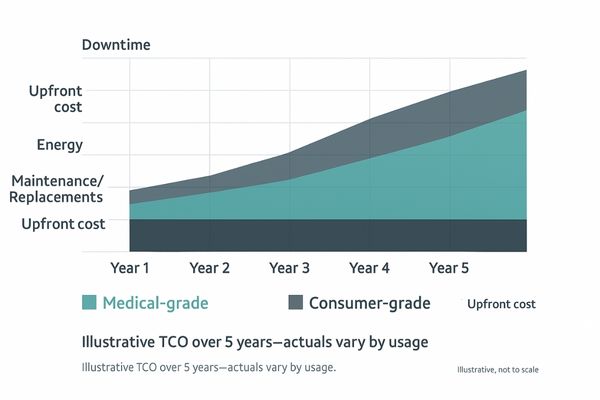
While the upfront investment for a medical-grade monitor is higher than for a consumer display, its long-term value proposition is far superior. These devices are built with higher-quality components and are designed for 24/7 operation, leading to a much longer operational lifespan. Their brightness and color accuracy remain stable over many years of use, whereas consumer displays often degrade quickly, requiring frequent and costly replacement. This durability results in a lower total cost of ownership (TCO)12 over a typical 5-year period. More importantly, the clinical impact13 delivers an invaluable return. By enabling more accurate and efficient procedures, these monitors directly contribute to better patient outcomes and reduced complication rates. Clinicians consistently report less eye strain and faster decision-making when working with high-quality displays, which boosts productivity and reduces burnout in a demanding environment. For any healthcare institution, investing in the right tools is a direct investment in patient safety and clinical excellence.
Conclusion
Investing in certified, high-performance medical-grade monitors for cardiac interventions is essential for ensuring procedural accuracy, improving patient safety, and achieving long-term operational efficiency in the cath lab.
📩 Want expert advice on selecting the best monitors for cardiac interventions? Contact Martin at martin@reshinmonitors.com to explore Reshin’s specialized cath lab display solutions.
-
Explore how medical-grade monitors enhance safety and precision in cardiac procedures, ensuring optimal patient outcomes. ↩
-
Learn about ROC curve analysis and its significance in evaluating diagnostic tests, crucial for improving clinical decision-making. ↩
-
Explore this link to understand how medical-grade displays enhance diagnostic accuracy and improve patient outcomes. ↩
-
Explore how a 4K display enhances clarity and detail in medical imaging, crucial for accurate diagnostics. ↩
-
Learn about DICOM Part 14 calibration to understand its role in ensuring image quality and consistency in medical imaging. ↩
-
Understanding FDA 510(k) clearance is crucial for ensuring compliance and safety in medical device manufacturing. ↩
-
Exploring the IEC 60601 standards will provide insights into essential safety and performance requirements for medical devices. ↩
-
Learn about the importance of minimizing latency in medical imaging for better clinical outcomes. ↩
-
Explore this link to understand how image fusion enhances procedural efficiency and improves patient care in cardiac interventions. ↩
-
Explore this link to understand how 4K imaging enhances diagnostic accuracy and patient care in medical environments. ↩
-
Learn why investing in medical-grade displays is crucial for safety, performance, and compliance in healthcare settings. ↩
-
Understanding TCO helps healthcare institutions make informed decisions about investments, ensuring long-term savings and efficiency. ↩
-
Exploring clinical impact can reveal how technology improves patient care, leading to better outcomes and enhanced healthcare practices. ↩


